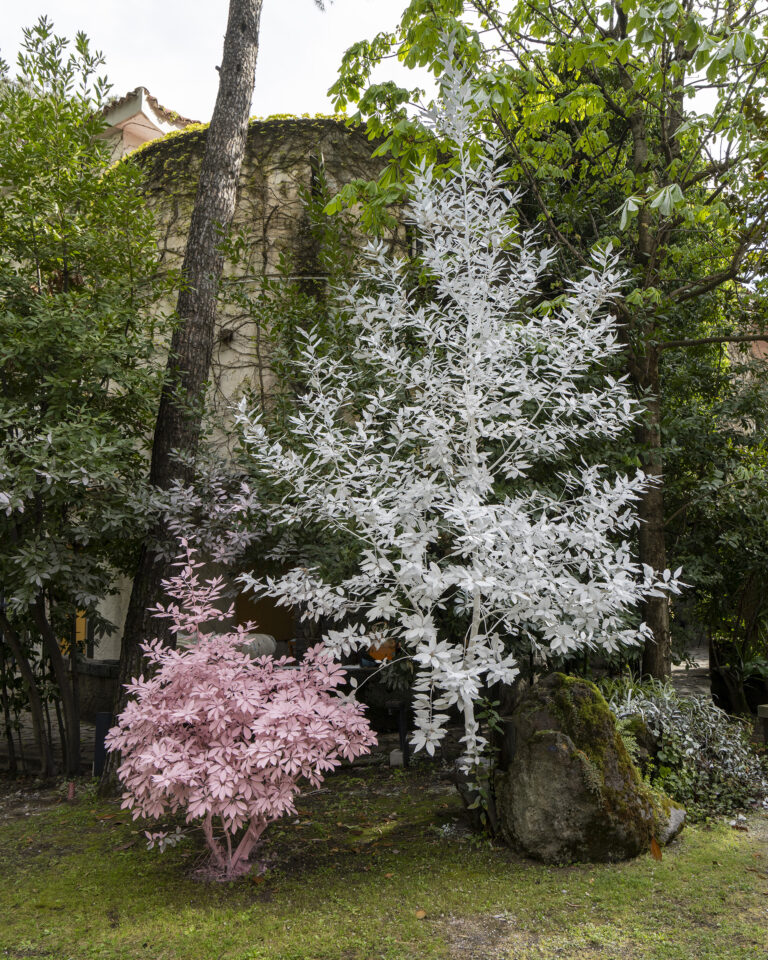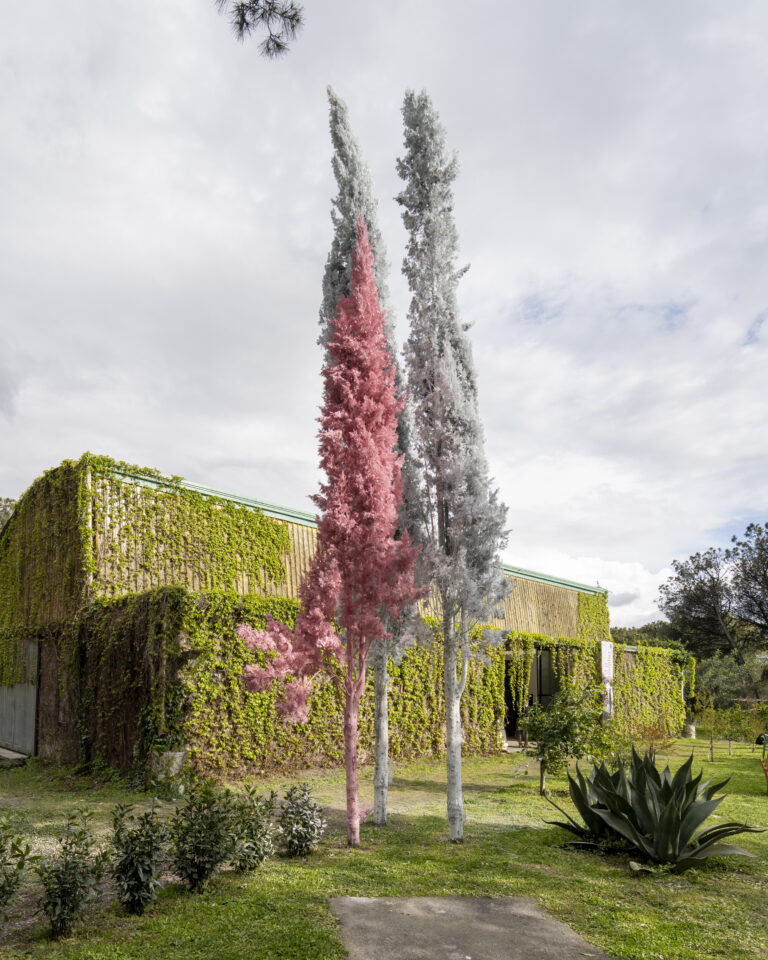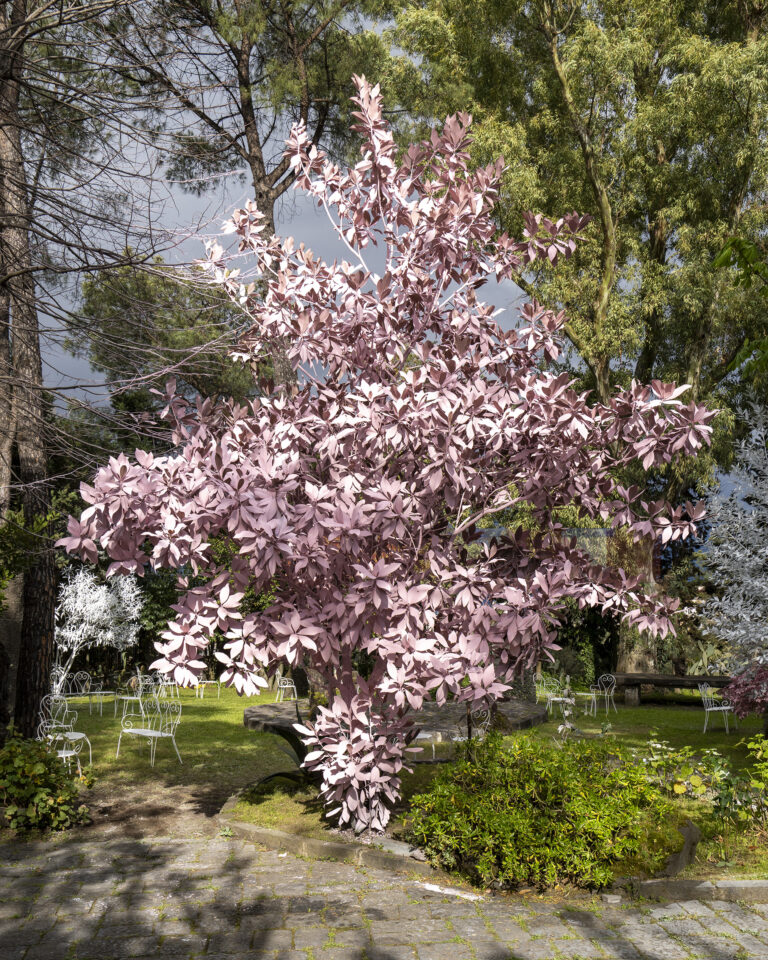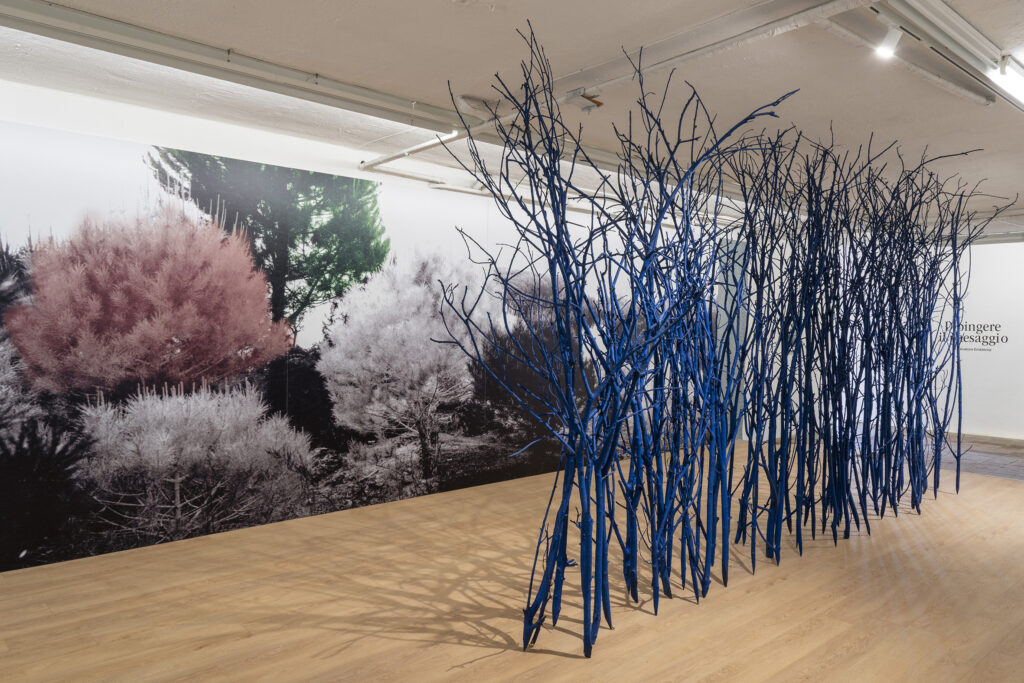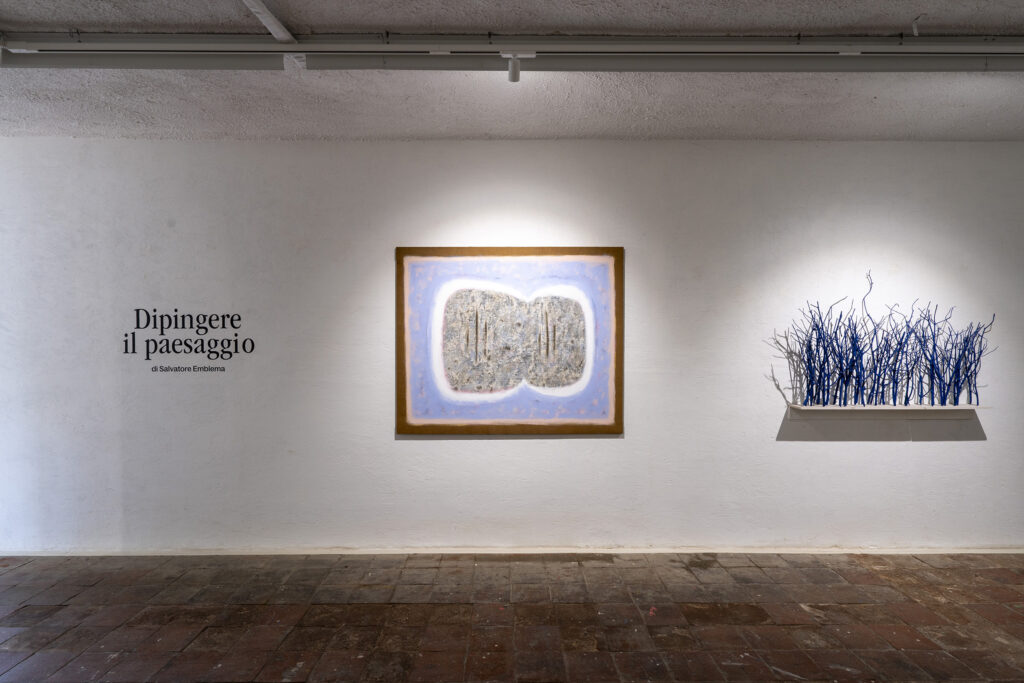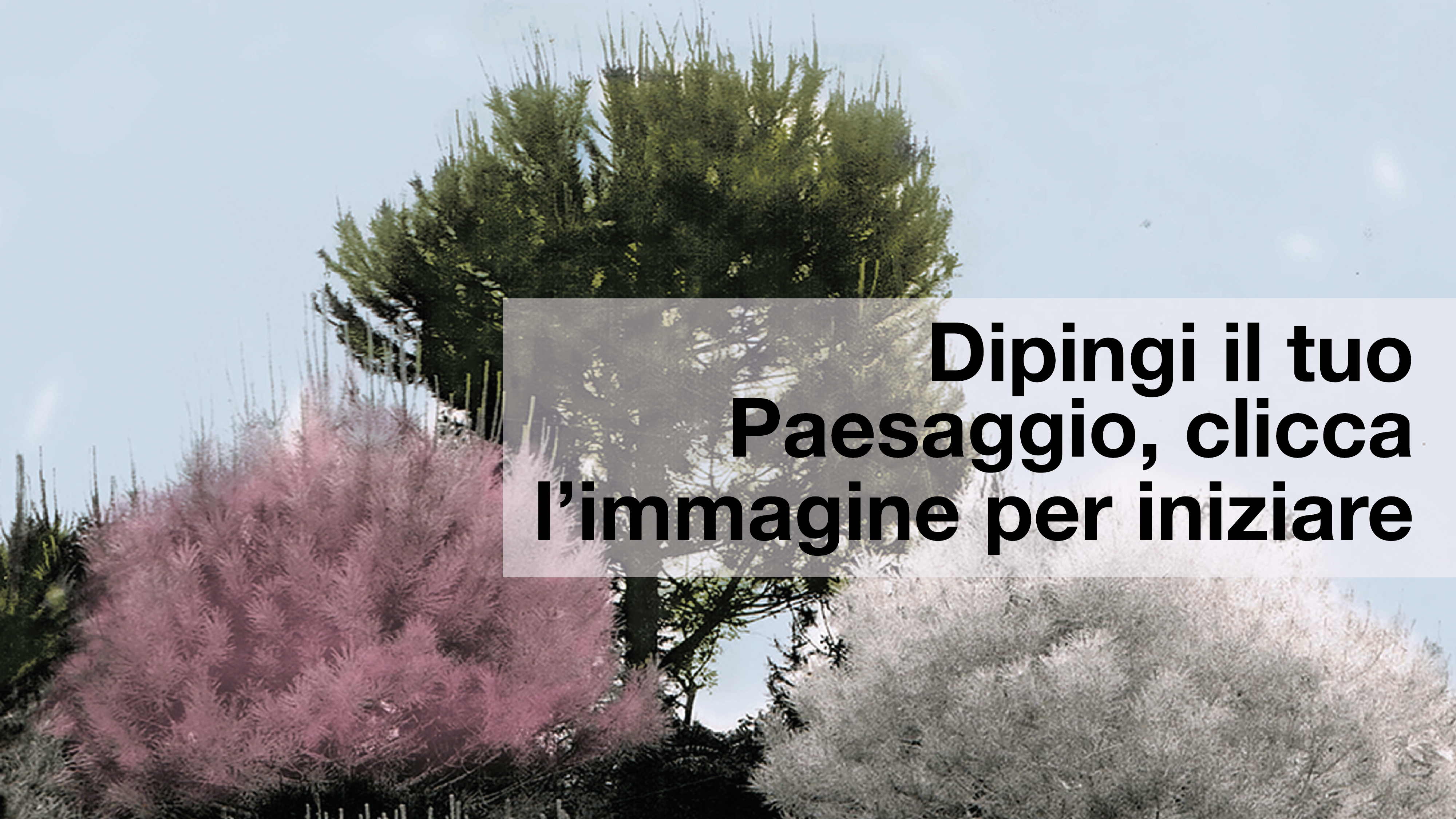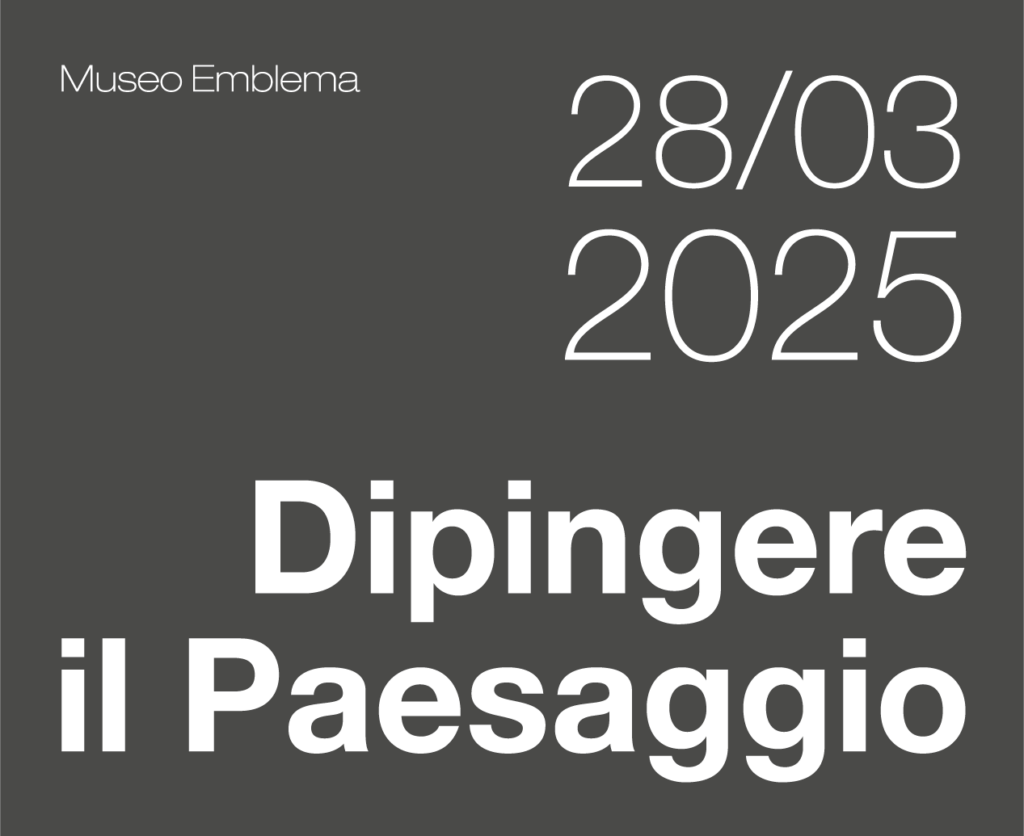
Dipingere il
Paesaggio
Come lo vedi quest’albero? È davvero verde?
Usa il verde, allora, il più bel verde della tua tavolozza.
E le ombre davvero sono blu?
Non aver paura di dipingerle più blu che puoi Paul Gauguin in conversazione con Paul Serusier Esiste il verso azzurro di Rubén Darío e la canzone grigia di Verlaine, le tigri blu di Borges, il cavaliere azzurro di Kandiskij e c’è il “paesaggio dipinto” con i colori blu, rosa, bianco, di Salvatore Emblema (Terzigno 1929 -2006). Le piante, si sa, si nutrono della luce solare, Emblema ha osservato l’effetto della luce sul paesaggio circostante alla sua casa-studio ai piedi del Vesuvio in diversi momenti del giorno, dando grande importanza a ogni dettaglio. E procedendo come un vero scultore di luce ha colorato rami e alberi come a volere ribaltare su sé stessi la loro ombra riportata sulla terra, un po’ come quella che Peter Pan perse e andò a cercare. La mostra prende il titolo dall’installazione ambientale nella natura “Dipingere il paesaggio” che Emblema ha realizzato a Terzigno nel 1967. Un lavoro composto da un insieme di fascine di rami di castagni ridipinti in un colore blu Emblema che lo avvicinano agli altri interventi di Land Art, cioè di arte nel paesaggio, che avveniva negli stessi anni in Europa e America. Una etichetta che inizialmente accoglieva varie chiavi di lettura dai critici del tempo: “gioco con gli elementi”, “evasione nella natura”, “tracce scavate”, “trasformazione artificiale del mondo” e “ricerca del fiore blu”. Ecco i rami blu di Emblema ritrovati sotto il Vesuvio. Ma anche la “trasformazione artificiale del mondo” la si ritrova in alcuni scatti fotografici, sempre del 1967, nei quali si vede come l’artista di Terzigno fosse intervenuto con pigmenti naturali (rosa e bianco) sugli alberi di pino circostanti la sua casa-studio, cambiandogli colore. Un’azione bloccata in un fermo immagine, che fissa ad un attimo preciso il ciclo di vita di uno dei suoi interventi di “dipingere il paesaggio”, in questo caso destinato a scomparire nel tempo. Nella ex casa-studio dell’artista a Terzigno, diventata Museo nel 2001, con la mostra, si ripropone quel clima di condivisione che l’artista creava ospitando gli amici durante l’equinozio di Primavera: una “festa”, come la definiva lo stesso Emblema, per celebrare il momento in cui il periodo di luce e quello di buio, hanno circa la stessa durata, allestendo una selezione di opere, tra interno e esterno del museo. Salvatore Emblema è conosciuto come l’artista della luce, materia, colore, trasparenza, monocromia, immaterialità. Sono queste le parole che ricorrono di più nella descrizione critica del suo lavoro pittorico. Tuttavia, Emblema parte inizialmente (metà degli anni Cinquanta) dalla figurazione per poi raggiungere, dopo anni di ricerche e studio, una forma di arte astratta, riducendo la rappresentazione del reale ai suoi elementi fondamentali, ad una struttura il più possibile ferma e oggettiva. L’artista amava ripetere che un’opera è riuscita quando non racconta lo spazio e la natura ma diventa essa stessa spazio e natura. E nel suo caso, è soprattutto memoria della natura e della sua luce. Lo spazio/paesaggio non è visto come una semplice cornice neutrale della rappresentazione della natura. In quanto ritaglio visuale di uno spazio, la costruzione poetica del paesaggio in Emblema costituisce un ideale punto di osservazione da cui sondare e porre in relazione molteplici aspetti testuali; e ciò ancor più se si tiene a mente che il paesaggio si configura come il luogo d’incontro privilegiato tra la realtà e la soggettività dell’osservatore. A ben vedere, infatti, l’atto di descrivere il paesaggio non costituisce un atto di mimesis del reale, ma una costruzione interpretativa, in cui lo sguardo, la mente e la mano di chi osserva e dipinge rivestono ruoli fondamentali. Il paesaggio, insomma, non costituisce una riproduzione “meccanica” dello spazio (reale o fittizio), ma risente della mediazione dello sguardo di chi crea uno spazio nel cosiddetto testo visivo, affidandogli uno specifico ruolo. E del resto, quando si serve di fotografie, Emblema applica alle sue opere il filtro creativo, e quindi deformante, della memoria. C’è una foto di Emblema del 1967 che lo ritrae nel suo paesaggio vulcanico di Terzigno con lo sguardo rivolto verso noi spettatori. L’artista è lui stesso parte di quello che lo circonda e entra anche lui come ombra riportata della natura naturans e come parte di essa assorbe la luce, si fa attraversare, come un corpo in trasparenza. Un’immagine al contrario dei romantici personaggi dipinti, sempre di spalle a chi guarda, dal pittore Caspar David Friedrich. In questa immagine, invece, sembra di ritrovare le parole dello scrittore Carlo Emilio Gadda che nel 1952 scriveva: «Il paesaggio e il terreno io li guardo e li percorro studiandomi a riconoscere in loro le componenti essenziali della vita, della mente, della cultura e della storia degli umani, così paese e terra non si dissociano mai, per me, dai termini dialettici di un mondo, di un ambiente, di un luogo» 1. Vita avventurosa quella di Salvatore Emblema che dal piccolo centro alle falde del Vesuvio intraprende la sua carriera artistica partendo da Roma. Nella galleria San Marco, nel 1954, ha la sua prima personale dove espone lavori materici e collage, fatti con le sabbie macinate dalle polveri vesuviane, i primi, e con foglie disseccate, i secondi. Nelle prime si serve di lapilli su tavole lignee, frutto di un processo costruttivo e di esperimenti materici, in quanto la materia si fa essa stessa soggetto dell’opera, mentre nelle seconde, come nei ritratti della moglie del 1956, sono eseguite con la tecnica della fullografia (ossia collage di foglie su tela). Opere materiche alle quali si affiancano già dal 1967 le sue sperimentazioni ambientali nella natura che fanno pensare allo stesso percorso di un grande della storia dell’arte del secolo scorso, Piet Mondrian 2. Nato anche lui come artista figurativo e giunto poi alla sua forma di arte astratta dopo anni di studio. E la chiave per ricostruire il suo percorso sono gli alberi, e quindi il paesaggio, come per Emblema. Carlo Ludovico Ragghianti, lo studioso italiano che ha posto l’accento su questa fase della pittura di Mondrian, sottolineava che: «La ricerca sul rapporto tra verticali e orizzontali, le determinazioni dove ogni forma o massa elaborata non può e non vuole nascondere lo scheletro geometrico, il ritmo ordinatore della scacchiera che è anche qui trasparente». Mondrian, inizialmente, fu ispirato dalle forme caotiche e complesse degli alberi per poi procedere sulla loro semplificazione, limitando i colori utilizzati e riducendo i rami a linee verticali e orizzontali. Con questa ricerca Mondrian arrivò a una vera e propria grammatica fatta di sole forme e colori. “L’albero rosso”, opera del 1908 dipinta nella cittadina costiera olandese di Domburg, raffigura un grande melo che occupa tutta la composizione. Non c’è profondità tra i rami del grande albero e il cielo blu della sera sul mare, né l’orizzonte appena accennato contribuisce a suggerire la distanza tra i diversi piani. Mondrian procede così spedito per la sua strada verso la semplificazione cromatica. L’albero rosso sarà seguito a stretto giro da un’opera meno nota, “L’albero blu”, che raffigura la stessa pianta, ma con un grado d’astrazione ancora più elevato, dal momento che qui vengono meno anche le nodosità e la ruvidezza del tronco dell’albero rosso, e la figura del melo diventa una silhouette in contrasto col cielo. «Spazio limitato il paesaggio, ma aperto, perché, a differenza degli spazi chiusi, ha sopra di sé il cielo, cioè lo spazio illimitato; e non rappresenta l’infinito […] ma si apre all’infinito, pur nella finitezza del suo essere limitato: costituendosi come presenza, e non rappresentazione, dell’infinito nel finito», scriveva il filosofo Rosario Assunto nel suo testo su “Il paesaggio e l’estetica” del 1973. Alla ricerca di uno spazio illimitato, al di sopra del cielo, Emblema volge il suo sguardo verso modelli in scala, reti, teli, gabbie autoportanti che mette in scena ai piedi del Vesuvio. “Filtri” che venivano posti tra l’osservatore e la natura circostante in grado di mutare luce e colore, pur senza modificare la realtà. Emblema non faceva che riproporre in questo modo, in scala maggiore l’idea della luce, del colore e della trasparenza che aveva enunciato nel suo “manifesto poetico”.
«Nelle sue installazioni, coerentemente alla ricerca del rapporto tra opera e contesto, l’universo-quadro si dilata fin quasi a scomparire, a diventare ‘trasparente’, per catturare l’ambiente – in un certo senso la natura si ‘rappresenta’ da sé – e lo svolgersi tridimensionale di alcuni suoi lavori innesca un confronto con l’intorno attraverso strutture geometriche che si installano nel paesaggio, intercettando tensioni spaziali in cui il dato naturale rappresenta un esito inedito e lungimirante. È come se l’artista verificasse in questa nuova ridefinizione del suo agire una geografia formale e poetica che ne amplifica la risonanza estetica e diventa ambiziosamente territoriale, operando il passaggio decisivo dal frammento ‘naturale’, foglia o polvere che sia, alla ‘natura’ in sé intesa come paesaggio esteriore e interiore, quello su cui il «guardiano della torre» spingeva il suo sguardo sempre più lontano, fino al cielo» 3 .
Sculture realizzate con materiali industriali, semilavorati e prefabbricati in metallo, “griglie” che interagiscono con lo spazio circostante utilizzando la linea come forma scultorea. Emblema attraversa i territori della sua sperimentazione, detessendo la materia della tela e generando un’opera reticolare che successivamente, prende corpo e forma in una tessitura multipla, una scenografia territoriale che si fa oltrepassare dal paesaggio. Sono strutture primarie che, come una rete, danno vita a forme geometriche elementari allo scopo di creare opere pure, che si sviluppano in verticale, che come nel caso delle sue opere su tela di juta, da corpi solidi e tridimensionali perdono peso raggiungendo la trasparenza.
«Che cos’è la trasparenza allora, se non il tentativo di eliminare ogni corpo opaco che si metta in mezzo tra i nostri occhi e la luce?» scriveva Emblema. Le forme scultoree incontrano il paesaggio che le circonda trascinando con sé nella memoria, una traccia, un segno lasciato o anche un vuoto segnato. La sua opera collocata sullo sfondo della natura contiene la visione della natura stessa.
Con le parole di Emblema:
«Non imito la natura, creo entro le sue leggi. La luce del sole penetra il dipinto», in questo caso “il corpo della scultura, come penetra la terra”. Io faccio solo due tipi di quadri, o sono paesaggi o sono corpi nudi. A volte sono tutte e due le cose>>
Salvatore Emblema, 1979
There is Rubén Darío’s blue verse and Verlaine’s grey song, Borges’s blue tigers, Kandiskij’s blue knight, and there is Salvatore Emblema’s (Terzigno 1929 -2006) painted landscape in blue, pink, white. Plants, as we know, feed on sunlight, Emblema observed the effect of light on the landscape around his home-studio at the foot of Vesuvius at different times of the day, giving great importance to every detail. And proceeding like a true sculptor of light, he coloured branches and trees as if to turn their shadow back onto the earth, a bit like the one Peter Pan lost and went looking for.
The exhibition takes its title from the environmental installation in nature Painting the Landscape that Emblema created in Terzigno in 1967. A work composed of a set of bundles of chestnut branches repainted in Emblema’s blue colour, which brought him closer to the other Land Art interventions, i.e. art in the landscape, that took place in the same years in Europe and America. A label that initially received various interpretations from the critics of the time: “playing with the elements”, “escapism in nature”, “hollowed-out traces”, “artificial transformation of the world’ and ‘search for the blue flower”. Here are the blue branches of Emblema re-found under the Vesuvius. But the ‘artificial transformation of the world’ can also be found in some photographs, also from 1967, in which we can see how the artist from Terzigno had intervened with natural pigments (pink and white) on the pine trees surrounding his home-studio, changing their colour. An action frozen in a still image, which fixes at a precise moment the life cycle of one of his interventions
of “painting the landscape”, in this case destined to disappear in time.
In the artist’s former home-studio in Terzigno, which became a museum in 2001, the exhibition re-proposes that atmosphere of sharing, that the artist created by hosting friends during the Spring Equinox: a “feast”, as Emblema himself defined it, to celebrate the moment when the period of light and the period of darkness, have approximately the same duration, setting up a selection of works, between the interior and exterior of the museum.
Salvatore Emblema is known as the artist of light, matter, colour, transparency, monochrome, immateriality. These are the words that recur most in the critical description of his pictorial work. However, Emblema initially started out (mid-1950s) with figuration and then, after years of research and study, reached a form of abstract art, reducing the representation of reality to its fundamental elements, to a structure that was as still and objective as possible. The artist was fond of repeating that a work is successful when it does not narrate space and nature but becomes space and nature itself.
And in his case, it is above all the memory of nature and its light. Space/landscape is not seen as a mere neutral frame for the representation of nature. As a visual cutout of a space, the poetic construction of the landscape in Emblema constitutes an ideal observation point from which to probe and relate multiple textual aspects; and this even more if we bear in mind that the landscape is configured as the privileged meeting place between reality and the subjectivity of the observer. On closer inspection, in fact, the act of describing the landscape does not constitute an act of mimesis of reality, but an interpretative construction, in which the gaze, the mind and the hand of the observer and painter play fundamental roles. The landscape, in short, does not constitute a “mechanical” reproduction of space (real or fictitious), but is affected by the mediation of the gaze of the person who creates a space in the so-called visual text, entrusting it with a specific role. And after all, when using photographs, Emblema applies the creative, and therefore deforming, filter of memory to his works. There is a photo of Emblema from 1967 that shows him in his volcanic landscape of Terzigno with his gaze turned towards us viewers. The artist is himself a part of his surroundings and he too enters as a reported shadow of natura naturans and as a part of it absorbs the light. The artist allows himself to be passed through, like a body in transparency. An image in contrast to the romantic characters painted, always with their backs to the viewer, as in Caspar David Friedrich paintings. In this image, on the other hand, we seem to find the words of the writer Carlo Emilio Gadda who wrote in 1952:
«I look at the landscape and the land and I walk through them, studying myself to recognize in them the essential components of human life, mind, culture and history, so that country and land are never dissociated, for me, from the dialectical terms of a world, of an environment, of a place».1
Salvatore Emblema’s life was an adventurous one. From the small town at the foot of Vesuvius, he embarked on his artistic career from Rome. In the San Marco gallery, in 1954, he had his first solo show where he exhibited material works and collages, made with sand ground from Vesuvian dust, the former, and with dried leaves, the latter. In his earlier works Emblema uses lapilli on wooden boards, the result of a constructive process and material experiments, as the material itself becomes the subject of the work.
The portraits of his wife in 1956 are executed using the fullografia technique (fullografia is a word made up by the artist), i.e. collage of dried leaves on canvas. These are material works that have been joined since 1967 by his environmental experiments in nature that bring to mind the same path of a great figure in te history of art of the last century, Piet Mondrian.2
He too was born as a figurative artist and then arrived at his form of abstract art after years of study. And the key to reconstructing his path are the trees, and thus the landscape, as for Emblema.
Carlo Ludovico Ragghianti, the Italian scholar who placed the emphasis on this phase of Mondrian’s painting, highlighted:
«The research into the relationship between verticals and horizontals, the determinations where each elaborate form or mass cannot and will not conceal the geometric skeleton, the ordering rhythm of the chessboard that is also transparent here».
Mondrian was initially inspired by the chaotic and complex forms of trees and then proceeded to simplify them, limiting the colours used and reducing the branches to vertical and horizontal lines. Through this research, Mondrian created a new style of painting that was made up of only shapes and colours.
“The Red Tree”, painted in the Dutch coastal town of Domburg in 1908, shows a large apple tree that takes up the whole picture. There is no depth between the branches of the tree and the blue evening sky over the sea, and the horizon is barely visible, so it is hard to tell how far away the different parts of the painting are.
This is an example of Mondrian’s move towards using fewer and simpler colours. The Red Tree will be closely followed by a lesser-known work, The Blue Tree, which also depicts the same plant, but with an even higher degree of abstraction. In this work, the knottiness and roughness of the red tree’s trunk are also eliminated, and the figure of the apple tree becomes a silhouette against the sky.
«The landscape is a limited space, but open, because, unlike closed spaces, it has the sky above it, i.e. unlimited space; and it does not represent the infinite [...] but opens up to the infinite, even in the finiteness of its being limited: constituting itself as the presence, and not the representation, of the infinite in the finite»
wrote the philosopher Rosario Assunto in his 1973 text on The Landscape and Aesthetics.
In search of an unlimited space, above the sky, Emblema turned his gaze towards scale models, nets, sheets, self-supporting cages that he staged at the foot of Vesuvius. “Filters” that were placed between the observer and the surrounding nature, capable of changing light and colour without altering reality. Emblema was merely re-proposing in this way, on a larger scale, the idea of light, colour and transparency that he had enunciated in his “poetic manifesto”.
«In his installations, consistently with the search for the relationship between work and context, the painting universe dilates until it almost disappears, to become ‘transparent’, to capture the environment. In a certain sense, nature “represents” itself - and the three-dimensional unfolding of some of his works triggers a confrontation with the surroundings through geometric structures that are installed in the landscape, intercepting spatial tensions in which the natural datum represents an unprecedented and far-sighted outcome. It is as if the artist verified in this new redefinition of his action a formal and poetic geography that amplifies its aesthetic resonance and becomes ambitiously territorial, making the decisive shift from the “natural” fragment, whether leaf or dust, to “nature” in itself understood as an exterior and interior landscape, the one on which the guardian of the tower’ pushed his gaze further and further, up to the sky»3.
Sculptures made from industrial, semi finished and prefabricated metal materials, ‘grids’ that interact with the surrounding space using the line as sculptural form. Emblema traverses the territories of his experimentation, de weaving the material of the canvas and generating a reticular work that subsequently takes on shape and form in a multiple weaving, a territorial scenography that is transcended by the landscape. They are primary structures that, like a net, give life to elementary geometric forms with the aim of creating pure works, which develop vertically, which, as in the case of his works on jute canvas, from solid, three dimensional bodies lose weight, achieving transparency.
«What is transparency then, if not the attempt to eliminate every opaque shape that stands between our eyes and the light?»
wrote Emblema. The sculptural forms meet the landscape around them, dragging with them into memory, a trace, a mark left or even a marked void. His work set against the backdrop of nature contains the vision of nature itself. In the words of Emblema:
«I do not imitate nature, I create within its laws. The sunlight penetrates the painting»
in this case “the body of the sculpture, as it penetrates the earth”.
«How do you see this tree? Is it really green? Use green, then, the most vivid green on your palette. And are the shadows really blue? Don’t be afraid to paint them as blue as you can»
— Paul Gauguin in conversation with Paul Serusier
«I only do two types of paintings, either they are landscapes or they are naked bodies. Sometimes they are both»
— Salvatore Emblema, 1979
Paint the
landscape
di Renata Caragliano e Emanuele Leone Emblema

Dipingere il
Paesaggio
Come lo vedi quest’albero? È davvero verde?
Usa il verde, allora, il più bel verde della tua tavolozza.
E le ombre davvero sono blu?
Non aver paura di dipingerle più blu che puoi Paul Gauguin in conversazione con Paul Serusier Esiste il verso azzurro di Rubén Darío e la canzone grigia di Verlaine, le tigri blu di Borges, il cavaliere azzurro di Kandiskij e c’è il “paesaggio dipinto” con i colori blu, rosa, bianco, di Salvatore Emblema (Terzigno 1929 -2006). Le piante, si sa, si nutrono della luce solare, Emblema ha osservato l’effetto della luce sul paesaggio circostante alla sua casa-studio ai piedi del Vesuvio in diversi momenti del giorno, dando grande importanza a ogni dettaglio. E procedendo come un vero scultore di luce ha colorato rami e alberi come a volere ribaltare su sé stessi la loro ombra riportata sulla terra, un po’ come quella che Peter Pan perse e andò a cercare. La mostra prende il titolo dall’installazione ambientale nella natura “Dipingere il paesaggio” che Emblema ha realizzato a Terzigno nel 1967. Un lavoro composto da un insieme di fascine di rami di castagni ridipinti in un colore blu Emblema che lo avvicinano agli altri interventi di Land Art, cioè di arte nel paesaggio, che avveniva negli stessi anni in Europa e America. Una etichetta che inizialmente accoglieva varie chiavi di lettura dai critici del tempo: “gioco con gli elementi”, “evasione nella natura”, “tracce scavate”, “trasformazione artificiale del mondo” e “ricerca del fiore blu”. Ecco i rami blu di Emblema ritrovati sotto il Vesuvio. Ma anche la “trasformazione artificiale del mondo” la si ritrova in alcuni scatti fotografici, sempre del 1967, nei quali si vede come l’artista di Terzigno fosse intervenuto con pigmenti naturali (rosa e bianco) sugli alberi di pino circostanti la sua casa-studio, cambiandogli colore. Un’azione bloccata in un fermo immagine, che fissa ad un attimo preciso il ciclo di vita di uno dei suoi interventi di “dipingere il paesaggio”, in questo caso destinato a scomparire nel tempo. Nella ex casa-studio dell’artista a Terzigno, diventata Museo nel 2001, con la mostra, si ripropone quel clima di condivisione che l’artista creava ospitando gli amici durante l’equinozio di Primavera: una “festa”, come la definiva lo stesso Emblema, per celebrare il momento in cui il periodo di luce e quello di buio, hanno circa la stessa durata, allestendo una selezione di opere, tra interno e esterno del museo. Salvatore Emblema è conosciuto come l’artista della luce, materia, colore, trasparenza, monocromia, immaterialità. Sono queste le parole che ricorrono di più nella descrizione critica del suo lavoro pittorico. Tuttavia, Emblema parte inizialmente (metà degli anni Cinquanta) dalla figurazione per poi raggiungere, dopo anni di ricerche e studio, una forma di arte astratta, riducendo la rappresentazione del reale ai suoi elementi fondamentali, ad una struttura il più possibile ferma e oggettiva. L’artista amava ripetere che un’opera è riuscita quando non racconta lo spazio e la natura ma diventa essa stessa spazio e natura. E nel suo caso, è soprattutto memoria della natura e della sua luce. Lo spazio/paesaggio non è visto come una semplice cornice neutrale della rappresentazione della natura. In quanto ritaglio visuale di uno spazio, la costruzione poetica del paesaggio in Emblema costituisce un ideale punto di osservazione da cui sondare e porre in relazione molteplici aspetti testuali; e ciò ancor più se si tiene a mente che il paesaggio si configura come il luogo d’incontro privilegiato tra la realtà e la soggettività dell’osservatore. A ben vedere, infatti, l’atto di descrivere il paesaggio non costituisce un atto di mimesis del reale, ma una costruzione interpretativa, in cui lo sguardo, la mente e la mano di chi osserva e dipinge rivestono ruoli fondamentali. Il paesaggio, insomma, non costituisce una riproduzione “meccanica” dello spazio (reale o fittizio), ma risente della mediazione dello sguardo di chi crea uno spazio nel cosiddetto testo visivo, affidandogli uno specifico ruolo. E del resto, quando si serve di fotografie, Emblema applica alle sue opere il filtro creativo, e quindi deformante, della memoria. C’è una foto di Emblema del 1967 che lo ritrae nel suo paesaggio vulcanico di Terzigno con lo sguardo rivolto verso noi spettatori. L’artista è lui stesso parte di quello che lo circonda e entra anche lui come ombra riportata della natura naturans e come parte di essa assorbe la luce, si fa attraversare, come un corpo in trasparenza. Un’immagine al contrario dei romantici personaggi dipinti, sempre di spalle a chi guarda, dal pittore Caspar David Friedrich. In questa immagine, invece, sembra di ritrovare le parole dello scrittore Carlo Emilio Gadda che nel 1952 scriveva: «Il paesaggio e il terreno io li guardo e li percorro studiandomi a riconoscere in loro le componenti essenziali della vita, della mente, della cultura e della storia degli umani, così paese e terra non si dissociano mai, per me, dai termini dialettici di un mondo, di un ambiente, di un luogo» 1. Vita avventurosa quella di Salvatore Emblema che dal piccolo centro alle falde del Vesuvio intraprende la sua carriera artistica partendo da Roma. Nella galleria San Marco, nel 1954, ha la sua prima personale dove espone lavori materici e collage, fatti con le sabbie macinate dalle polveri vesuviane, i primi, e con foglie disseccate, i secondi. Nelle prime si serve di lapilli su tavole lignee, frutto di un processo costruttivo e di esperimenti materici, in quanto la materia si fa essa stessa soggetto dell’opera, mentre nelle seconde, come nei ritratti della moglie del 1956, sono eseguite con la tecnica della fullografia (ossia collage di foglie su tela). Opere materiche alle quali si affiancano già dal 1967 le sue sperimentazioni ambientali nella natura che fanno pensare allo stesso percorso di un grande della storia dell’arte del secolo scorso, Piet Mondrian 2. Nato anche lui come artista figurativo e giunto poi alla sua forma di arte astratta dopo anni di studio. E la chiave per ricostruire il suo percorso sono gli alberi, e quindi il paesaggio, come per Emblema. Carlo Ludovico Ragghianti, lo studioso italiano che ha posto l’accento su questa fase della pittura di Mondrian, sottolineava che: «La ricerca sul rapporto tra verticali e orizzontali, le determinazioni dove ogni forma o massa elaborata non può e non vuole nascondere lo scheletro geometrico, il ritmo ordinatore della scacchiera che è anche qui trasparente». Mondrian, inizialmente, fu ispirato dalle forme caotiche e complesse degli alberi per poi procedere sulla loro semplificazione, limitando i colori utilizzati e riducendo i rami a linee verticali e orizzontali. Con questa ricerca Mondrian arrivò a una vera e propria grammatica fatta di sole forme e colori. “L’albero rosso”, opera del 1908 dipinta nella cittadina costiera olandese di Domburg, raffigura un grande melo che occupa tutta la composizione. Non c’è profondità tra i rami del grande albero e il cielo blu della sera sul mare, né l’orizzonte appena accennato contribuisce a suggerire la distanza tra i diversi piani. Mondrian procede così spedito per la sua strada verso la semplificazione cromatica. L’albero rosso sarà seguito a stretto giro da un’opera meno nota, “L’albero blu”, che raffigura la stessa pianta, ma con un grado d’astrazione ancora più elevato, dal momento che qui vengono meno anche le nodosità e la ruvidezza del tronco dell’albero rosso, e la figura del melo diventa una silhouette in contrasto col cielo. «Spazio limitato il paesaggio, ma aperto, perché, a differenza degli spazi chiusi, ha sopra di sé il cielo, cioè lo spazio illimitato; e non rappresenta l’infinito […] ma si apre all’infinito, pur nella finitezza del suo essere limitato: costituendosi come presenza, e non rappresentazione, dell’infinito nel finito», scriveva il filosofo Rosario Assunto nel suo testo su “Il paesaggio e l’estetica” del 1973. Alla ricerca di uno spazio illimitato, al di sopra del cielo, Emblema volge il suo sguardo verso modelli in scala, reti, teli, gabbie autoportanti che mette in scena ai piedi del Vesuvio. “Filtri” che venivano posti tra l’osservatore e la natura circostante in grado di mutare luce e colore, pur senza modificare la realtà. Emblema non faceva che riproporre in questo modo, in scala maggiore l’idea della luce, del colore e della trasparenza che aveva enunciato nel suo “manifesto poetico”.
«Nelle sue installazioni, coerentemente alla ricerca del rapporto tra opera e contesto, l’universo-quadro si dilata fin quasi a scomparire, a diventare ‘trasparente’, per catturare l’ambiente – in un certo senso la natura si ‘rappresenta’ da sé – e lo svolgersi tridimensionale di alcuni suoi lavori innesca un confronto con l’intorno attraverso strutture geometriche che si installano nel paesaggio, intercettando tensioni spaziali in cui il dato naturale rappresenta un esito inedito e lungimirante. È come se l’artista verificasse in questa nuova ridefinizione del suo agire una geografia formale e poetica che ne amplifica la risonanza estetica e diventa ambiziosamente territoriale, operando il passaggio decisivo dal frammento ‘naturale’, foglia o polvere che sia, alla ‘natura’ in sé intesa come paesaggio esteriore e interiore, quello su cui il «guardiano della torre» spingeva il suo sguardo sempre più lontano, fino al cielo» 3 .
Sculture realizzate con materiali industriali, semilavorati e prefabbricati in metallo, “griglie” che interagiscono con lo spazio circostante utilizzando la linea come forma scultorea. Emblema attraversa i territori della sua sperimentazione, detessendo la materia della tela e generando un’opera reticolare che successivamente, prende corpo e forma in una tessitura multipla, una scenografia territoriale che si fa oltrepassare dal paesaggio. Sono strutture primarie che, come una rete, danno vita a forme geometriche elementari allo scopo di creare opere pure, che si sviluppano in verticale, che come nel caso delle sue opere su tela di juta, da corpi solidi e tridimensionali perdono peso raggiungendo la trasparenza.
«Che cos’è la trasparenza allora, se non il tentativo di eliminare ogni corpo opaco che si metta in mezzo tra i nostri occhi e la luce?» scriveva Emblema. Le forme scultoree incontrano il paesaggio che le circonda trascinando con sé nella memoria, una traccia, un segno lasciato o anche un vuoto segnato. La sua opera collocata sullo sfondo della natura contiene la visione della natura stessa.
Con le parole di Emblema:
«Non imito la natura, creo entro le sue leggi. La luce del sole penetra il dipinto», in questo caso “il corpo della scultura, come penetra la terra”. Io faccio solo due tipi di quadri, o sono paesaggi o sono corpi nudi. A volte sono tutte e due le cose>>
Salvatore Emblema, 1979
Paint the
Landscape
There is Rubén Darío’s blue verse and Verlaine’s grey song, Borges’s blue tigers, Kandiskij’s blue knight, and there is Salvatore Emblema’s (Terzigno 1929 -2006) painted landscape in blue, pink, white. Plants, as we know, feed on sunlight, Emblema observed the effect of light on the landscape around his home-studio at the foot of Vesuvius at different times of the day, giving great importance to every detail. And proceeding like a true sculptor of light, he coloured branches and trees as if to turn their shadow back onto the earth, a bit like the one Peter Pan lost and went looking for.
The exhibition takes its title from the environmental installation in nature Painting the Landscape that Emblema created in Terzigno in 1967. A work composed of a set of bundles of chestnut branches repainted in Emblema’s blue colour, which brought him closer to the other Land Art interventions, i.e. art in the landscape, that took place in the same years in Europe and America. A label that initially received various interpretations from the critics of the time: “playing with the elements”, “escapism in nature”, “hollowed-out traces”, “artificial transformation of the world’ and ‘search for the blue flower”. Here are the blue branches of Emblema re-found under the Vesuvius. But the ‘artificial transformation of the world’ can also be found in some photographs, also from 1967, in which we can see how the artist from Terzigno had intervened with natural pigments (pink and white) on the pine trees surrounding his home-studio, changing their colour. An action frozen in a still image, which fixes at a precise moment the life cycle of one of his interventions
of “painting the landscape”, in this case destined to disappear in time.
In the artist’s former home-studio in Terzigno, which became a museum in 2001, the exhibition re-proposes that atmosphere of sharing, that the artist created by hosting friends during the Spring Equinox: a “feast”, as Emblema himself defined it, to celebrate the moment when the period of light and the period of darkness, have approximately the same duration, setting up a selection of works, between the interior and exterior of the museum.
Salvatore Emblema is known as the artist of light, matter, colour, transparency, monochrome, immateriality. These are the words that recur most in the critical description of his pictorial work. However, Emblema initially started out (mid-1950s) with figuration and then, after years of research and study, reached a form of abstract art, reducing the representation of reality to its fundamental elements, to a structure that was as still and objective as possible. The artist was fond of repeating that a work is successful when it does not narrate space and nature but becomes space and nature itself.
And in his case, it is above all the memory of nature and its light. Space/landscape is not seen as a mere neutral frame for the representation of nature. As a visual cutout of a space, the poetic construction of the landscape in Emblema constitutes an ideal observation point from which to probe and relate multiple textual aspects; and this even more if we bear in mind that the landscape is configured as the privileged meeting place between reality and the subjectivity of the observer. On closer inspection, in fact, the act of describing the landscape does not constitute an act of mimesis of reality, but an interpretative construction, in which the gaze, the mind and the hand of the observer and painter play fundamental roles. The landscape, in short, does not constitute a “mechanical” reproduction of space (real or fictitious), but is affected by the mediation of the gaze of the person who creates a space in the so-called visual text, entrusting it with a specific role. And after all, when using photographs, Emblema applies the creative, and therefore deforming, filter of memory to his works. There is a photo of Emblema from 1967 that shows him in his volcanic landscape of Terzigno with his gaze turned towards us viewers. The artist is himself a part of his surroundings and he too enters as a reported shadow of natura naturans and as a part of it absorbs the light. The artist allows himself to be passed through, like a body in transparency. An image in contrast to the romantic characters painted, always with their backs to the viewer, as in Caspar David Friedrich paintings. In this image, on the other hand, we seem to find the words of the writer Carlo Emilio Gadda who wrote in 1952:
«I look at the landscape and the land and I walk through them, studying myself to recognize in them the essential components of human life, mind, culture and history, so that country and land are never dissociated, for me, from the dialectical terms of a world, of an environment, of a place».1
Salvatore Emblema’s life was an adventurous one. From the small town at the foot of Vesuvius, he embarked on his artistic career from Rome. In the San Marco gallery, in 1954, he had his first solo show where he exhibited material works and collages, made with sand ground from Vesuvian dust, the former, and with dried leaves, the latter. In his earlier works Emblema uses lapilli on wooden boards, the result of a constructive process and material experiments, as the material itself becomes the subject of the work.
The portraits of his wife in 1956 are executed using the fullografia technique (fullografia is a word made up by the artist), i.e. collage of dried leaves on canvas. These are material works that have been joined since 1967 by his environmental experiments in nature that bring to mind the same path of a great figure in te history of art of the last century, Piet Mondrian.2
He too was born as a figurative artist and then arrived at his form of abstract art after years of study. And the key to reconstructing his path are the trees, and thus the landscape, as for Emblema.
Carlo Ludovico Ragghianti, the Italian scholar who placed the emphasis on this phase of Mondrian’s painting, highlighted:
«The research into the relationship between verticals and horizontals, the determinations where each elaborate form or mass cannot and will not conceal the geometric skeleton, the ordering rhythm of the chessboard that is also transparent here».
Mondrian was initially inspired by the chaotic and complex forms of trees and then proceeded to simplify them, limiting the colours used and reducing the branches to vertical and horizontal lines. Through this research, Mondrian created a new style of painting that was made up of only shapes and colours.
“The Red Tree”, painted in the Dutch coastal town of Domburg in 1908, shows a large apple tree that takes up the whole picture. There is no depth between the branches of the tree and the blue evening sky over the sea, and the horizon is barely visible, so it is hard to tell how far away the different parts of the painting are.
This is an example of Mondrian’s move towards using fewer and simpler colours. The Red Tree will be closely followed by a lesser-known work, The Blue Tree, which also depicts the same plant, but with an even higher degree of abstraction. In this work, the knottiness and roughness of the red tree’s trunk are also eliminated, and the figure of the apple tree becomes a silhouette against the sky.
«The landscape is a limited space, but open, because, unlike closed spaces, it has the sky above it, i.e. unlimited space; and it does not represent the infinite [...] but opens up to the infinite, even in the finiteness of its being limited: constituting itself as the presence, and not the representation, of the infinite in the finite»
wrote the philosopher Rosario Assunto in his 1973 text on The Landscape and Aesthetics.
In search of an unlimited space, above the sky, Emblema turned his gaze towards scale models, nets, sheets, self-supporting cages that he staged at the foot of Vesuvius. “Filters” that were placed between the observer and the surrounding nature, capable of changing light and colour without altering reality. Emblema was merely re-proposing in this way, on a larger scale, the idea of light, colour and transparency that he had enunciated in his “poetic manifesto”.
«In his installations, consistently with the search for the relationship between work and context, the painting universe dilates until it almost disappears, to become ‘transparent’, to capture the environment. In a certain sense, nature “represents” itself - and the three-dimensional unfolding of some of his works triggers a confrontation with the surroundings through geometric structures that are installed in the landscape, intercepting spatial tensions in which the natural datum represents an unprecedented and far-sighted outcome. It is as if the artist verified in this new redefinition of his action a formal and poetic geography that amplifies its aesthetic resonance and becomes ambitiously territorial, making the decisive shift from the “natural” fragment, whether leaf or dust, to “nature” in itself understood as an exterior and interior landscape, the one on which the guardian of the tower’ pushed his gaze further and further, up to the sky»3.
Sculptures made from industrial, semi finished and prefabricated metal materials, ‘grids’ that interact with the surrounding space using the line as sculptural form. Emblema traverses the territories of his experimentation, de weaving the material of the canvas and generating a reticular work that subsequently takes on shape and form in a multiple weaving, a territorial scenography that is transcended by the landscape. They are primary structures that, like a net, give life to elementary geometric forms with the aim of creating pure works, which develop vertically, which, as in the case of his works on jute canvas, from solid, three dimensional bodies lose weight, achieving transparency.
«What is transparency then, if not the attempt to eliminate every opaque shape that stands between our eyes and the light?»
wrote Emblema. The sculptural forms meet the landscape around them, dragging with them into memory, a trace, a mark left or even a marked void. His work set against the backdrop of nature contains the vision of nature itself. In the words of Emblema:
«I do not imitate nature, I create within its laws. The sunlight penetrates the painting»
in this case “the body of the sculpture, as it penetrates the earth”.
«How do you see this tree? Is it really green? Use green, then, the most vivid green on your palette. And are the shadows really blue? Don’t be afraid to paint them as blue as you can»
— Paul Gauguin in conversation with Paul Serusier
«I only do two types of paintings, either they are landscapes or they are naked bodies. Sometimes they are both»
— Salvatore Emblema, 1979
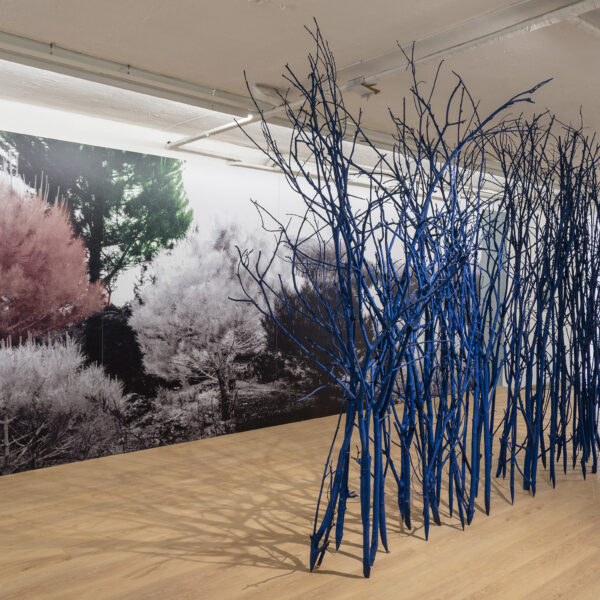
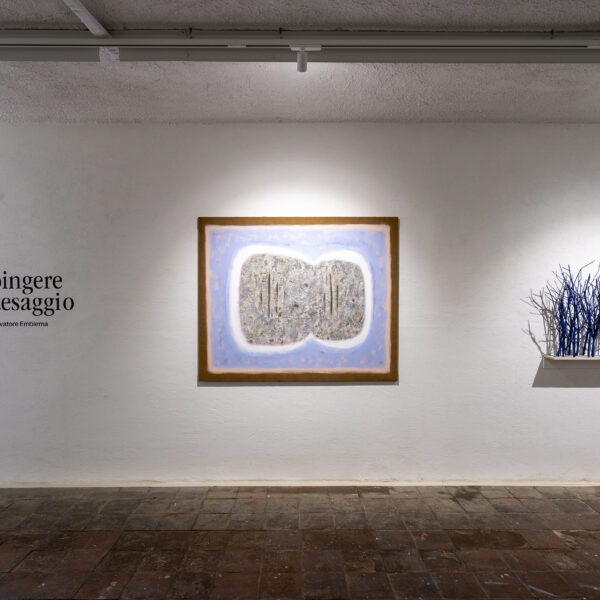
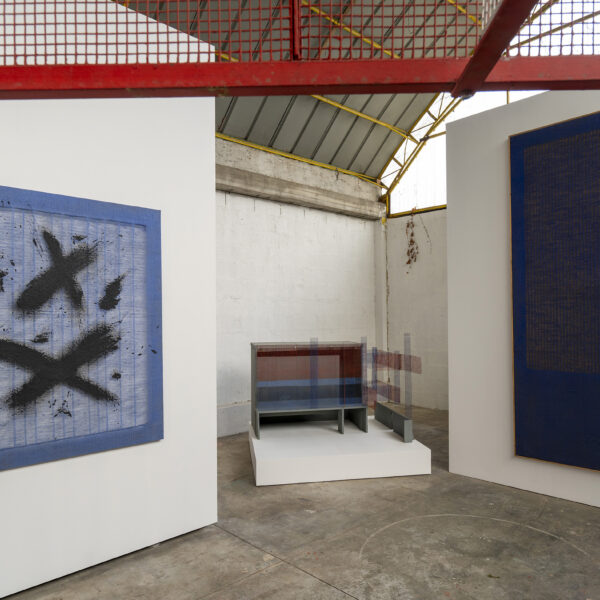
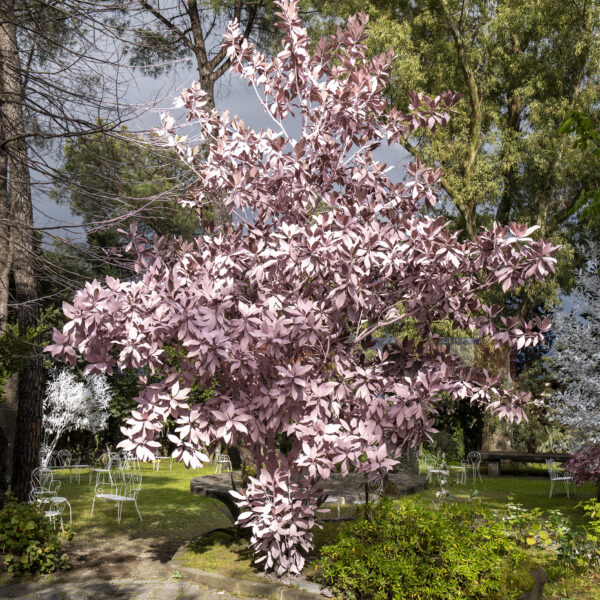
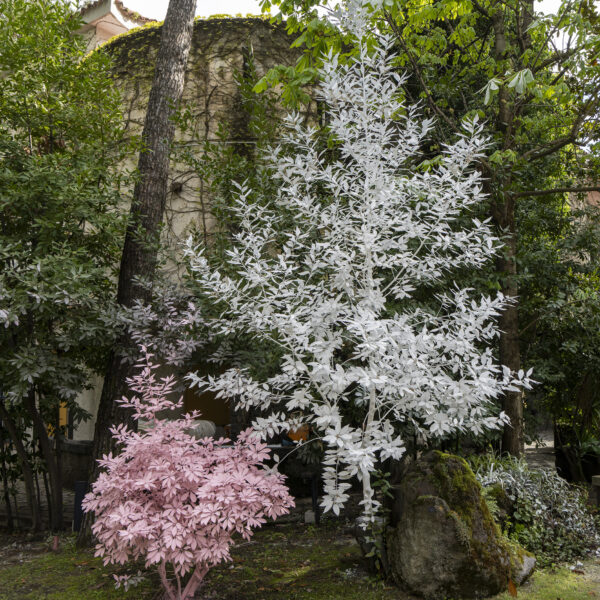
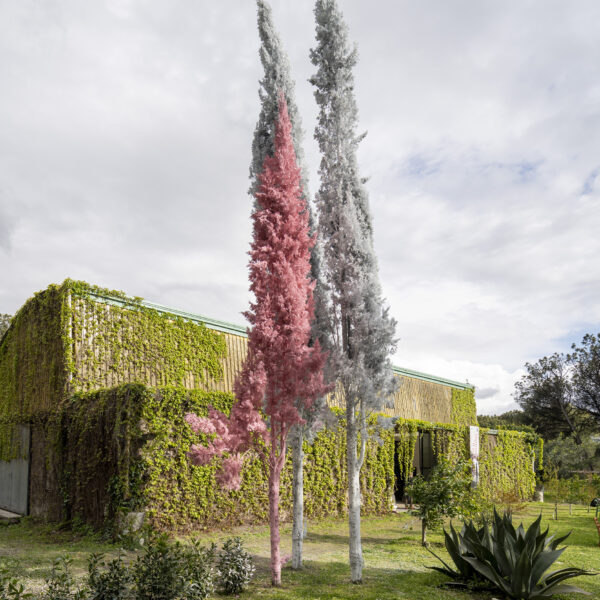
- Via Salvatore Emblema, 37,
Terzigno, IT 80040 - + 39 081 8274081
- museo@salvatoreemblema.it
archivio@salvatoreemblema.it
didattica@salvatoreemblema.it
Writings on this website are literary reworkings on interviews, memoirs, and suggestions made by the artist’s heirs. They are also drown from audiovisual materials, documents, recordings kept in the archives of Museo Emblema.
- da lun- ven 9:00 -13:00
sab-dom su prenotazione
Address List
- Via Salvatore Emblema, 37,
Terzigno, IT 80040 - + 39 081 8274081
- museo@salvatoreemblema.it
archivio@salvatoreemblema.it
didattica@salvatoreemblema.it
HOURS
- da lun- ven 9:00 -13:00
sab-dom su prenotazione
PARTNER





Writings on this website are literary reworkings on interviews, memoirs, and suggestions made by the artist’s heirs. They are also drown from audiovisual materials, documents, recordings kept in the archives of Museo Emblema.
